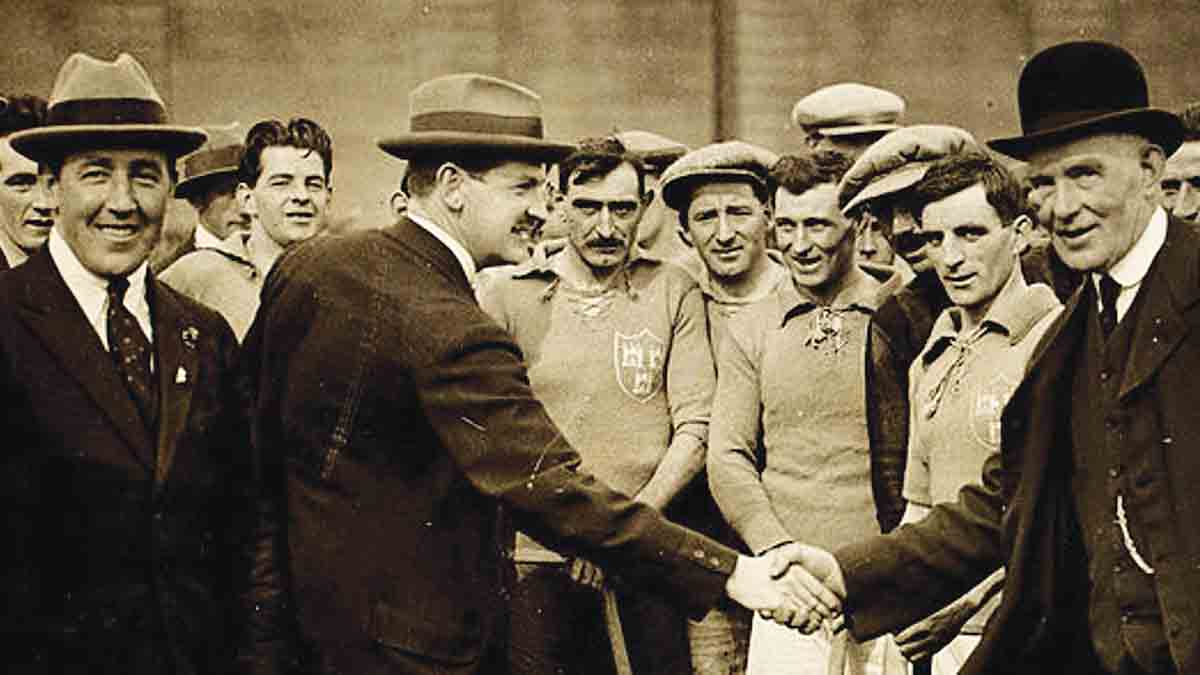Over the past few weeks; I’ve recounted the stories of County Kilkenny heroes of the War of Independence. Since last week’s article, I accompanied the Kilkenny Heritage Walkers to Nowlan Park to mark the hundredth anniversary of the death of a great sportsman and patriot, James Nowlan, after whom the mighty venue is named.
He was born in Monasterevin in 1862. His father was a cooper by profession and a member of the embryonic Irish Republican Brotherhood (IRB). James followed in his father’s footsteps and trained as a cooper in O’Sullivan’s Brewery.
He also inherited his father’s Republican sentiments. The story of Ireland’s long struggle for freedom moved him deeply. He joined the Gaelic League and became politically involved. He was a founder member of St Patrick’s Brass and Reed Band, whose nationalistic ethos chimed with his own vision of a Free Ireland.
Elected an alderman of Kilkenny Corporation, he used the position from day one to assist the fledgling GAA which had been formed fourteen years earlier to promote our native sports and culture.
In 1900, he was elected the first chairman of the GAA’s Leinster Council and at the 1901 GAA Congress he was appointed national president of the Association. His twenty-year term made him the longest serving holder of that post, and throughout his tenure he sought to wed the Association to the cause of Republicanism.
Nowlan joined Sinn Fein shortly after its formation in 1905, a fateful decision that meant a life of sacrifice… keeping one step ahead of the oppressor. He was among the hundreds of suspected rebels arrested in a countryside swoop by the British following the 1916 Rising.
Interned at a camp in Wales, he was released in August and resumed both his Republican activities and involvement with the GAA. He was arrested again in 1919 when the British found him in possession of a revolver and ammunition. His plea that he only wanted the gun to “guard GAA gate money” (the butt of many a fireside yarn in later years) failed to impress his captors and he received a one-month prison term.
Throughout the War of Independence he fearlessly made known his support for the resistance, despite the unwelcome attention this drew from the authorities.
At the 1921 Congress he was appointed Honorary GAA Life President of the Association, the only recipient of that position…a fitting tribute to a true local hero.
When he died in 1924, however, his grave at Glasnevin cemetery carried no recognition of a life devoted to his country’s independence and its unique sporting culture. That oversight was addressed in 2013 when the GAA erected a Celtic cross at his grave.
In 2009, the Sunday Tribune listed him as one of the 125 Most Influential People in GAA History But the greatest posthumous honour bestowed on James Nowlan was the building of the park in Kilkenny to cater for Gaelic games. Nowlan Park today has capacity for around 24,000 spectators.
Last Saturday, the Kilkenny Heritage Walkers arrived at Nowlan Park to pay tribute to him, kindly facilitated by park chairman PJ Kenny. Tom Kennedy spoke of the man and his turbulent times, sprinkling his witty and erudite presentation with anecdotes and a wealth of historical references.
Ailbhe Fitzgerald offered further insights, drawing on her passion for all things Irish, and she delivered a part of her talk in the native tongue, as befitting the man and his achievements. Historian Paddy Neary delved into the mists of time, highlighting the remarkable legacy that James Nowlan bequeathed, not just to Kilkenny, but to Ireland.
Later that day an All Ireland Under 20 Final was held in Nowlan Park to mark his 100th anniversary. I’d like to think that he heard some of the cheers that rose to Heaven as the two sides played the game he loved… at a venue bearing his name.
-John Fitzgerald




















